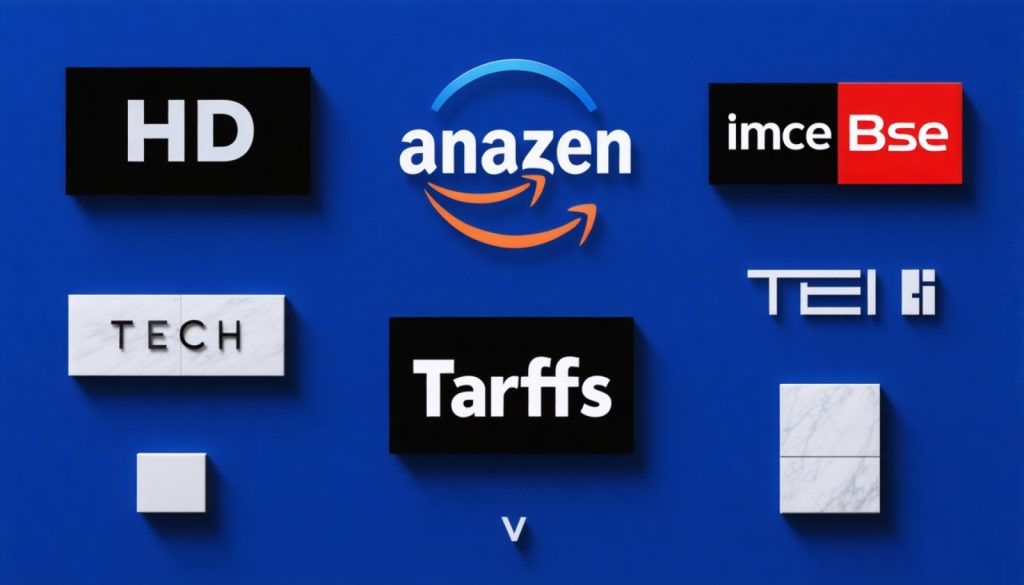
- The Trump administration’s announcement of robust tariffs on US trading partners sent shockwaves through the tech sector, impacting megacap stocks like Apple, Nvidia, and Meta.
- Apple’s stock dropped nearly 6%, while Nvidia and Meta saw declines of more than 3% and nearly 4% respectively, reflecting widespread market uncertainty.
- The Nasdaq-100 futures indicated a projected 3% dip, underscoring the anticipated market volatility.
- Analysts, including Dan Ives from Wedbush, emphasized the potential disruptions to global supply chains due to possible retaliatory tariffs from China and Taiwan.
- The tech giants face a strategic challenge: adapting to changing economic conditions while anticipating opportunities, such as Apple’s plans for U.S.-based facilities.
- Despite concerns, there is some relief for semiconductor companies as chips remain exempt from the new tariffs.
- The evolving situation demands agility and innovation, setting the stage for a transformation in global market dynamics.
Beneath the ethereal glow of screens, anxiety spread like wildfire through Silicon Valley. The Trump administration’s jarring announcement of robust tariffs sent tremors across the tech landscape, shaking the once-steady ground beneath megacap stocks like Apple, Nvidia, and Meta.
As dusk settled, the after-hours trading session turned tumultuous, echoing with the clamor of shifting numbers. With a swift stroke, new tariffs aimed at US trading partners, particularly those like China and Taiwan, carved out a deep chasm of uncertainty in the tech sector. The fallout was immediate: Apple swooped close to a 6% drop, while Nvidia and Meta were not far behind, their values shrinking by more than 3% and nearly 4%, respectively.
The Nasdaq-100 futures, a barometer of tech health, projected a foreboding forecast—a looming 3% dip when the stock market opened the following day. The night was restless for traders and investors alike, their minds alight with questions and calculations.
Analysts wasted no time dissecting the news, with seasoned observers like Dan Ives from Wedbush painting a grim picture. The spread of these tariffs seemed worse than the darkest predictions, striking a chord of unease with Wall Street watchers. The specter of a 34% reciprocal tariff from China and a 32% escalation from Taiwan hovered ominously. It was a calculated maneuver that threatened to unspool intricate global supply chains and rattle the tech behemoths that rely on them.
Apple, a titan that assembles nearly all its iPhones in the labyrinthine factories of China, now faced a daunting conundrum. Would there be exceptions allowed for companies expanding operations on American soil? A flicker of hope arose from Apple’s February announcement of new U.S.-based facilities, yet much remained uncertain.
Similarly, Nvidia and other semiconductor powerhouses wrestled with fears of pricing pressures and margin constrictions, their futures clouded by these sweeping changes. Yet, a flicker of reprieve emerged from the fine print—chips, a staple of their business, were exempt from the punitive tariffs.
As dawn approached, one question loomed large: How could these tech giants adapt and reorient their strategies in the face of economic adversity? The narrative was rich with challenges, mapping a path toward innovation-driven resilience, as these companies aimed to chart a course through turbulent waters.
Heartbeats synchronized with Wall Street’s electronic tick-tock as Thursday trading neared. The story unfolding was poised to redefine battle lines in a global marketplace, demanding both agility and foresight from a sector that thrives on the precision of both. The unfolding saga calls for nimble adaptation and a relentless pursuit of solutions, playing out on a global stage where every move could shape future destinies.
How Trump’s Tariffs Are Reshaping Silicon Valley: Impacts and Opportunities
Introduction
The recent announcement of new tariffs by the Trump administration has sent ripples throughout Silicon Valley, causing uncertainty among tech giants like Apple, Nvidia, and Meta. In this article, we’ll delve deeper into the potential impacts of these tariffs, how the tech industry might navigate these challenges, and what this means for consumers and investors.
Tariffs and Tech: Unpacking the Impact
The tech sector relies heavily on global supply chains, especially with components and manufacturing concentrated in countries like China and Taiwan. The introduction of robust tariffs poses several challenges:
1. Impact on Supply Chains: Tech companies could see increased costs and potential supply chain disruptions. Many firms might need to find alternative suppliers or even consider reshoring production. Sources like the Harvard Business Review note that diversifying supply chains can mitigate such risks.
2. Price Increases: With new tariffs, the cost of importing components may rise, which could lead to increased prices for consumer electronics. This is a natural consequence of tariff impositions as corroborated by historical trends documented by the Congressional Research Service.
3. Stock Market Reactions: As noted, companies like Apple already experienced significant after-hours stock price drops. Such volatility is often linked to market uncertainty but could present buying opportunities for strategic investors.
How Tech Giants Can Adapt
Despite these hurdles, there are strategies that tech companies might employ to adapt:
– Innovation and R&D: Increasing investment in research and development could allow companies to innovate their way out of higher-cost production models. This strategy aligns with the Silicon Valley ethos, as seen in companies like Google and Tesla.
– Reshoring Production: Establishing or expanding manufacturing in the US might offset some tariff burdens. Apple’s new U.S.-based facilities hint at a strategic move in this direction.
– Supplier Diversification: Relocating some supply chain dependencies to non-tariffed countries can minimize impact. Deloitte notes this as an effective measure in its logistics and supply chain management insights.
Real-World Use Cases and Insights
– Apple’s Operational Shift: While mainly reliant on China’s manufacturing prowess, Apple is already exploring U.S. manufacturing options, which could broaden in response to tariffs.
– Nvidia’s Strategic Planning: By focusing on diversifying product lines and ensuring chips remain tariff-free, Nvidia might cushion itself against some impacts.
Market Forecasts and Industry Trends
The immediate future will likely see:
– Short-term Volatility: As markets adjust to new tariffs, expect fluctuations. Long-term impacts will depend on consumer demand and companies’ strategic adaptations.
– Increased Localization Efforts: Tech giants could increasingly invest in local economies to sidestep tariffs, a trend supported by data from McKinsey that indicates a shift towards localized supply chains.
Recommendations for Investors and Consumers
Investors should remain vigilant for potential buying opportunities during market dips but stay informed about geopolitical shifts. Consumers might see price hikes, particularly in electronics—consider purchasing sooner if planning to replace devices.
Conclusion
The tech sector is no stranger to disruption, and these new tariffs present both a challenge and an opportunity. By embracing innovation, diversifying supply chains, and potentially reshoring production, companies can navigate these turbulent waters. For the latest insights on tech and business, visit Forbes.



